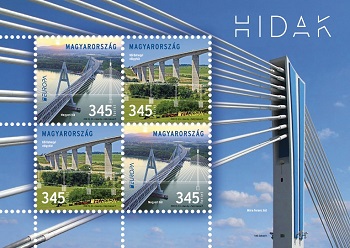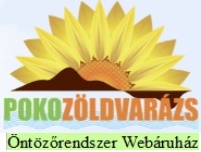
Europa 2018: Hidak - Bélyegblokk
Az Európai Postaüzemeltetők Egyesületének (PostEurop) tagjai évente bocsátanak ki azonos témában bélyeget, amivel a tagországok azonos értékeit és a filatélia fontosságát is bemutatják. Az „EUROPA” bélyeg jelenleg is az egyik legnépszerűbb gyűjtési tematika, és a hivatalos logóval ellátott kiadványok a legkeresettebb bélyegújdonságok között találhatók. A tagországok 2018-ra a hidak témakört választották a közös értékek bemutatása céljából. A 2x2 bélyegből álló magyar bélyegkisív Kara György grafikusművész tervei szerint a Pénzjegynyomda Zrt.-ben 70 000 példányban készült. Az újdonság május 2-től kapható az elsőnapi postákon, a Filapostán, továbbá megrendelhető a Magyar Posta internetes áruházán keresztül is. a is.
Bármelyik korban és bármelyik országban készült hidak funkcionalitásuk mellett mindig az összetartozás, az összeköttetés és a kapcsolatok szimbólumai. Az általuk nyújtott előnyök kézzelfoghatóak, a kisebbek egy közösség, a nagyobbak akár egy egész régió fejlődését támogathatják. Sok híd kiemelkedő építészeti megoldás, látványukkal a táj lenyűgöző részei lehetnek.
Az első címleten a Megyeri híd látható, amely a maga 1861 méteres hosszával jelenleg Magyarország második leghosszabb hídja, egyben a leghosszabb folyami híd hazánkban. Hosszirányban öt dilatációs szakaszból áll: külön szerkezetek a két végén az árterek fölötti és a középső részén a Szentendrei-sziget fölötti szakaszok, valamint a Nagy Duna ágat és a Szentendrei Duna ágat átívelő részek. A Nagy Duna ág fölötti 600 méter hosszú, 300 méter nyílású szerkezet Magyarország első ferdekábeles hídja, 100 méter magas pilonjai nagy „A” betűt formálnak. A pilonok szárai közül az egyikben lépcső, a másikban lift található. A 2006 és 2008 között épült híd a Budapestet körülölelő M0-ás autópálya északi szektorában található. Csodálatos mérnöki létesítmény, méltó a budapesti Duna-hidak családjához.
A második címleten bemutatott Kőröshegyi völgyhíd, amely 1872 méteres hosszával jelenleg Magyarország leghosszabb hídja, az M7-es autópálya Balaton melletti szakaszán található, Kőröshegy és Balatonföldvár szomszédságában. A 17 nyílású, feszített monolit vasbeton szerkezetű műtárgy 2004 és 2007 között épült. A pillérek közti támaszköze 120 méteres, a legmagasabb pillér 80 méter magas. Minden pillérében lépcső található, kettőbe a hídvizsgálatokat megkönnyítendő lift is épült. A közel 3%-os hosszesés eredményeként a két hídfő közti magasságkülönbség több mint 53 méter. A környezetvédelmi szempontokat figyelembe véve az egész hídról összegyűjtik a csapadékvizet, és csak több lépcsőben történő tisztítás után engedik vissza a természetbe. Egyedülálló, kiemelkedő, tekintélyt parancsoló mérnöki alkotás. A kisív keretrajzán a Szegedtől északra, az M43-as autópálya részeként épült, a Tisza felett átívelő
Móra Ferenc híd részlete tekinthető meg. Az első napi borítékon szintén a Megyeri híd és a HIDAK felirat (a Megyeri híd „A” betűt formáló pilonjának képi kompozíciójával) látható. Az alkalmi bélyegző grafikájának alapjául a Kisapostagot Dunavecsével összekötő, „Dunaújvárosi hídként” is nevezett Pentele híd sematikus ábrája szolgált.










